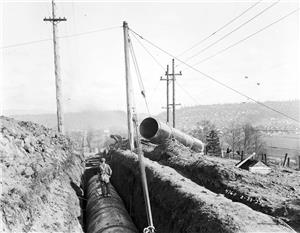On April 4, 1922, the City of Seattle Board of Public Works awards Grant Smith & Company the contract to construct Cedar River Pipeline Number Three at a cost of $1,468,602.50. This riveted steel pipeline of 66-inch diameter parallels Pipelines One and Two, which are wooden stave pipes. The wooden pipes, now showing their 20-year age, have suffered many small breaks and cannot fully serve Seattle.
Pipeline One was constructed in 1899, when Seattle’s population was 80,000. Pipeline Two was built when the population was 240,000. In 1920, 315,000 people called Seattle their home, and more water was needed.
In 1917, improvements were begun on Swan Lake near the Cedar River, to make it an impounding basin for four billion gallons of water. Pipeline Three was in the planning stages while this work was performed over the next few years.
At the time the contract was awarded in 1922, Seattle water storage in reservoirs and standpipes totaled 270 million gallons. In case of a complete shutdown of the Cedar River system, this would supply residents for only five days. Superintendent of Water L. B. Youngs (1860-1923) urged an early completion date for the new pipeline so that Swan Lake could be used as storage while repairs were done on Pipeline Number Two.
Work began apace, but on June 10, 1923, Youngs died. In recognition of his 28 years of service with the Water Department, City officials asked that Swan Lake be renamed to Youngs Lake.
On October 23, 1923, the first water was delivered to Seattle in Pipeline Number Three. The new pipeline was built of 66-inch steel pipe, and was 15 miles long, running from Youngs Lake to the Volunteer Park reservoir. It paralleled Pipeline One, except that through Renton’s business district it followed a path one block away. Upon reaching Seattle, it traveled along 20th Avenue S to Grand Street, then through Valentine Place to Rainier Avenue and Atlantic Street, and then along 18th Avenue S to E Prospect Street, and then up to the Volunteer Park reservoir.

